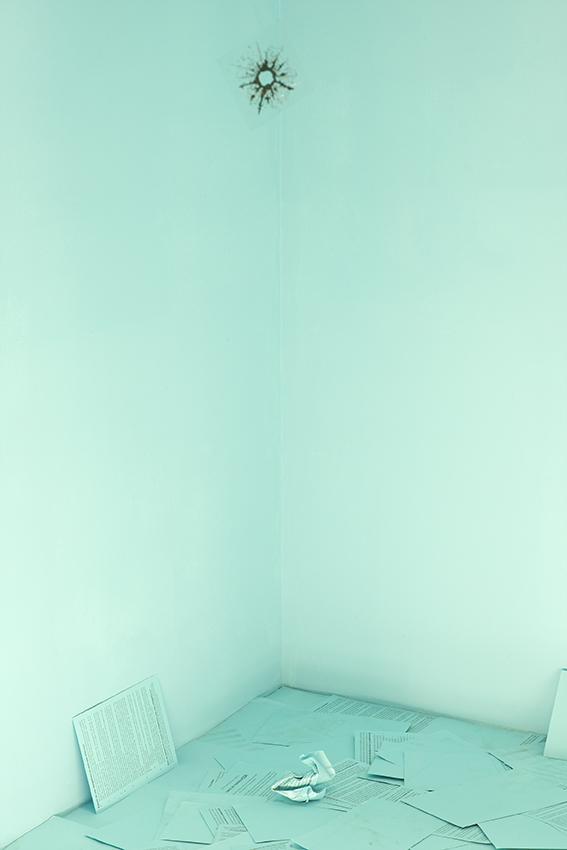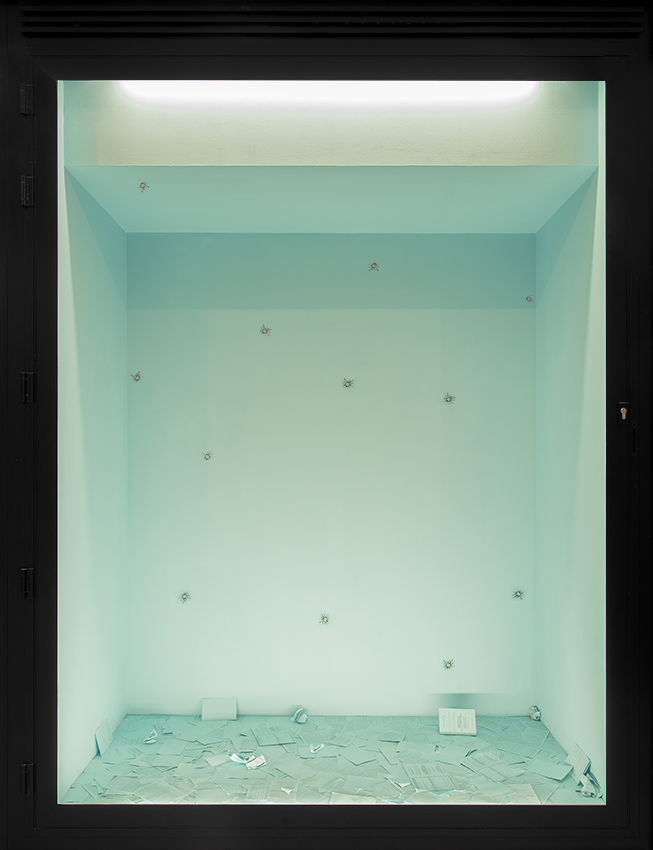Jacques André, Bullet Holes

Bullet Holes or the shop window blues
What mattered most was that the card was of the right tone of blue, this very specific, enveloping blue : and I am not talking about IKB, Prussian blue or Venetian blue, but about this blue that is sometimes invisible, sometimes intangible, but which nevertheless structures our social reality and, in particular, that of the artistic and creative world : "ONEM" blue.
A record of failure or success, it will be ours to discover it when the invitation is printed in a few days time. As the case may be, this might lead us to discuss the issue of the difficulty of representing, or conveying through the media, an immaterial reality.
But that is another matter ; let us get back to the point in hand or, rather, Jacques André.
Jacques accepted the status of artist/jobseeker a long time ago, in a post-modern society devoted to overconsumption, an overconsumption that he assumes and questions at the same time.
Experienced in this case and according to an etymological and metaphorical acceptance of the term, as a true "social abstraction", his status as a receiver of benefits has had a major influence on the development of several of his projects and the principles behind his creative work.
When he isn’t selling paintings featuring magnified "abstract works" corresponding to old signing-on stamps from different communes in the Brussels region, he will often make repeat purchases of the same objects (books, records and other cultural products).
To use his terminology, these ARTERS* (* achats à répétition, tentatives d’épuisement, reconstitutions de stocks) (meaning repetitive purchases, attempts to exhaust stocks, replenish stocks), which he describes as the fruit of a process that is always detailed as "extremely slow and complex, combining aesthetic, psychological, anecdotal and financial considerations", are part of an obvious critique of the consumerist compulsion in which citizens, and more so the unemployed, are trapped.
Another characteristic facet of Jacques André’s work lies in his fascination for children’s toys and practical jokes, derivatives that are often very revealing of our consumer society’s values. He gladly buys and collects them, and sometimes gladly uses them in his installations.
These two aspects of his work sometimes converge, as is the case here. Because, as you will undoubtedly understand when you receive the invitation card or see the installation, the fun and eponymous element of this project, which of course also contains aesthetic, social and sociological undertones, is comprised of holes and bullet holes applied to the glass of a shop window, graciously lent to the artist by Hopstreet Gallery in the Passage de la Galerie Rivoli.
"Damn ! I exhausted the stock of Bullet Holes at Picard-Megafun and the Palais des Cotillons !" Jacques told me on 29 December 2015.
In any case, the purchase of these Bullet Holes is classified as ARTERS * no. 163.
But let us return to the project’s spatial context : a simple shop window in a shopping arcade that is gradually turned into a "very eclectic - art’mall’.
The shop window, with its strict black metal frame, is simply painted in the abovementioned shade of blue.
It is empty, or almost. "ONEM" cards, which have been recuperated in or around the various employment offices, lie scattered on the ground. The failures of the system, if you like ; a system that actually excludes more and more people, including in the creative sector, the excluded people of "social abstraction".
And on the shop window’s glass, the aforementioned joke bullet holes pay tribute to trompe-l’oeil in a roundabout way.
The parodic echo of two bullet holes emphasizes the failure of a system or that of a model of a consumerist society, the fall and the "excess" of the latter and its reversed, immaterial mirror, equivalent to its absence and its emptiness.
But some would be tempted to also see here an abridged history of abstraction, or a new take on landscape painting, social realism or even, of course, a reference to Le Grand Verre by Marcel Duchamp, etc...
Passers-by, people buying art, we are all free to form our own opinion.
That being the case, a question still remains. The shop window is still a shop window, a real, large-sized frame, fitted with a door that opens, which essentially wants to be filled, even if only ephemerally.
All the more so since this plain-coloured background reminds us of a paler version of the real "non colour" of the digital age, this blue screen that serves as a backdrop for all virtual, media and TV realities.
Shall we open it ? Can we slip into it ? The question remains unanswered.
The only physical restriction is the size : 215 x 190 x 80 cm.
Possible answer at the preview or closing event of Bullet Holes.
Emmanuel Lambion

Bullet Holes - Curated by Emmanuel Lambion for HOPSTREET GALLERY WINDOWS
23 January - 05 March 2016
Opening Saturday 23 January 2016, 15-18h